Tolerance of Eremophilas to Heavy Frost
Hans Griesser; Eremophila Study Group
My garden at Gumeracha in the northern Adelaide Hills experiences lower night temperatures than Adelaide and a number of stiff frost nights even in “normal” winters. My garden is a good test case for the frost hardiness of plants, perhaps more so than the gardens of most other study group members, I suspect. As some eremophilas took many months to decide whether or not to re-shoot after the big freeze of 2006, I had to wait until I could collate the outcomes.
Since I had moved here in early 2002, eremophilas had generally done very well for me – until last winter, that is. This past winter indeed provided quite a test of frost tolerance (though I would have preferred to do without the experience) and sorted the real frost-hardy species from those that are less hardy. Many died, and many others were cut back, some quite severely, and in some cases re-shooting started as late as November. By way of comparison, in the previous four winters (2002 to 2005) I had lost only a few eremophila plants each winter, and invariably those were plants less than a year old; I had never lost an established eremophila plant during the previous winters. This time, however, the deaths included a number of plants that had thrived for years, some planted in early 2002.
Likewise, many established plants of other genera were killed by frost, and the number of deaths was much greater than in previous winters. All my Lechenaultia, most Eremaea and Beaufortia, and the majority of the banksias died. In contrast, most Correa, Acacia, Grevillea and Hakea survived, even those less than a year old. Surprisingly, most verticordias survived with little damage.
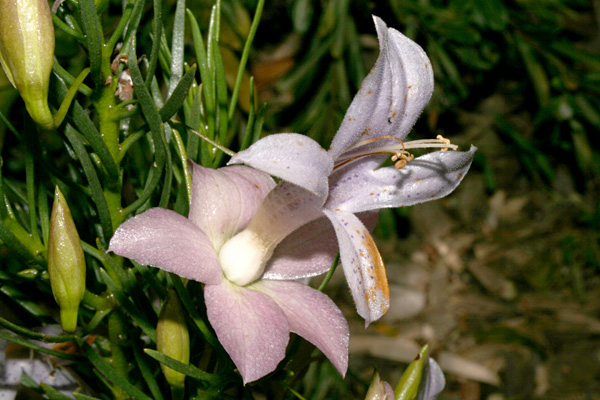 |
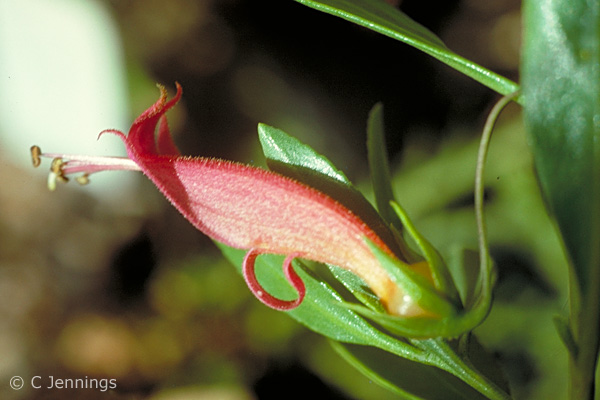 |
|
| Little or no damage – Left: Eremophila abietina, Right: Eremophila denticulata Photos: Alice Newton, Colin Jennings |
||
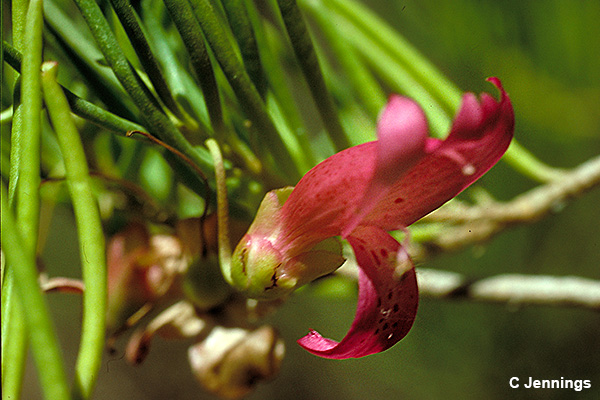 |
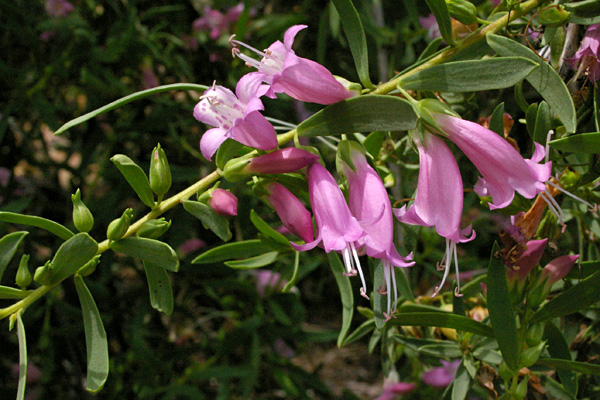 |
|
| Substantial damage but re-shooting – Left: Eremophila alternifolia, Right: Eremophila laanii Photos: Colin Jennings, Alice Newton |
||
I didn’t measure temperatures where the plants are, but from readings taken on a thermometer on the house wall under the veranda roof and observing the onset of frosts, I can extrapolate that during “normal” winters the lowest temperatures here would be around -5 or 6oC, whereas the winter of 2006 provided some temperature readings that were 4-5 degrees below normal. Thus, I estimate that on some nights the temperatures went to -9 to -11o.
Can I be sure that frost is to blame? The winter was quite dry and well-established plants were killed, which suggest that wet feet did not play a major role. On many eremophilas and other plants, the split bark – in some cases, shredded seems a better word – was obvious. On others the way the leaves and young branchlets turned a dark brown was different to what happens when the roots die from wet feet.
In addition to the intrinsic frost tolerance of a species, a number of factors can affect it either way. Location is one factor; but all my eremophilas are planted in a full-sun, exposed position on the upper slope of a gentle hill, with no uphill trees for protection. I had a few eremophila plants that I expected to be too frost sensitive (such as E.warnesii and E.willsii) in pots on a table under the roof of a north-facing veranda, and this protection was adequate. Age is another factor; the lower height and relatively less hardened lower bark of young plants makes them more frost sensitive, which probably explains why in previous winters the losses were plants less than a year old. For E.gibbosa, one five year old plant came back from extensive damage while a young plant, a cutting from the first, died. It may be that some of the plants listed below as killed might survive when older, but on the other hand the deaths also included many established plants. Conversely, some of the young plants might have been killed even by a milder winter. I have omitted from the table below a few species where the observations might be unreliable because the plants were still rather young and tender.
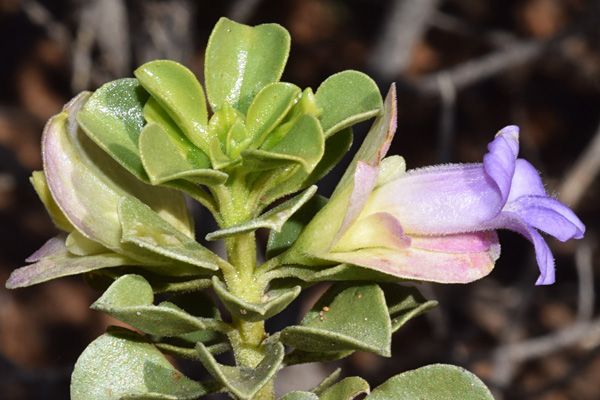 |
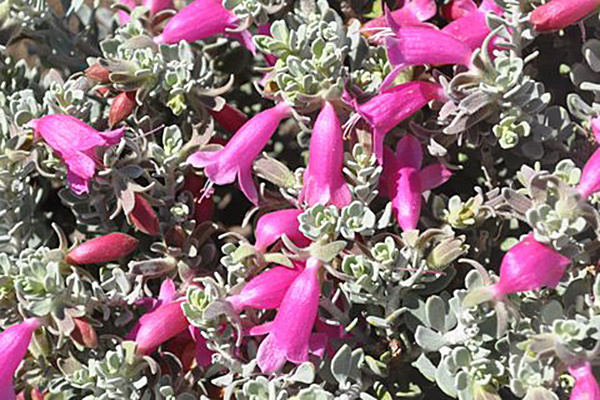 |
|
| Killed by frost – Left: Eremophila cuneifolia, Right: Eremophila glandulifera Photos: Mike Beamish, Brian Freeman |
||
Usually when I had more than one plant of a taxon, they behaved the same. For example, all five plants of E.splendens were killed; they were between 6 and 3 years old and had never shown signs of frost damage in previous winters. On the other hand, one plant of the pink-flowered form of E.racemosa died while three cream- flowered plants of the same species all survived with tip damage only. Maybe provenance plays a role. This may also be the reason why all four plants of E.nivea x E.drummondii (identical clones, three of the plants were cuttings from the first) were killed while plants of both parents survived with minor tip damage. Perhaps the hybrid came from a less frost-prone area. Unfortunately I don’t know the provenance of most of my eremophila plants; some were grown from cuttings from the specimens table of the APS Para District Group and other cuttings came from the gardens of other study group members, Ken Wames and Beverley Rice (thank you!).
Among the species that show great variability of forms, E.maculata plants showed little difference in frost tolerance apart from the more sensitive E.maculata var. brevifolia. Eremophila glabra forms showed more variability in frost tolerance, with some showing no damage at all whereas E.glabra ssp carnosa and the Canning Stock Route form suffered extensive damage but recovered, while the “Murchison River” form died. From the small number of taxa where I have both grafted and un-grafted plants, it seems to me that grafting has a minor effect if any, especially when leaves and branchlets are vulnerable to damage rather than the bark of the trunk.
Frost tolerance of Eremophila species and cultivars – Adelaide Hills, South Australia
| No damage E. abietina, adenotricha, decipiens, dichroantha, divaricata (both ssp), glabra (some forms), inflata, “blue” interstans, ionantha, longifolia, lucida, maculata (some forms), pinnatifida, serpens, serrulata? (ex Ken Wames), ternifolia. |
| Some tip damage but plants recovered readily E. bignoniiflora x alternifolia, biserrata, dempsteri, densifolia (ssps densifolia and capitata), denticulata ssp trisulcata, drummondii, gibbifolia, glabra (some forms), lehmanniana (though one of three plants died), maculata (some forms), maculata x duttonii, maculata x racemosa, malacoides, nivea, racemosa (cream flowered form), resinosa, scaberula, scoparia, subteretifolia, “Summertime Blue”, “3-way Cross”, “Wames’ Hybrid” (which Ken now calls “Nullarbor Nymph”), “Yanna Road”, and sp. nov. aff. gibbosa (low growing, broad fleshy leaves, ex Ken Wames) |
| Substantial damage, many or all leaves and branchlets dead but plant re-shooting from lower parts E. alternifolia, eriocalyx, gibbosa, glabra ssp carnosa, glabra “Canning Stock Route”, laanii, maculata var. brevifolia, metallicorum, rugosa, subfloccosa, veneta, viscida (pink flowered form), weldii. A few of these looked dead for quite a while until fresh shoots emerged. Don’t pull them up too early! |
| Substantial damage, plant re-shooting quickly from lower parts but fresh shoots killed by a late September frost and plant not shooting again E. brevifolia, microtheca, pantonii. |
| Killed E. arachnoides ssp tenera, calorhabdos (glabrous and Peak Charles forms), christophorii, clarkei x granitica (?), compacta, complanata, cuneifolia (grafted), delisseri (grafted), fasciata, georgei, glabra “Murchison River”, glandulifera, granitica, hillii, hygrophana, macdonnellii (several forms), macgillivrayi (grafted), mackinlayi, margarethae (grafted), mirabilis (grafted), neglecta, nivea x drummondii, occidens, oppositifolia (several forms), ovata, papillata, platycalyx, platythamnos, platythamnos x gibsonii (grafted), psilocalyx, purpurascens, racemosa (pink/orange flowered form), recurva, rostrata, splendens, stenophylla, strongylophylla, youngii (both ssp), “Rainbow Gem”, and a plant labeled nivea x carnosa which Ken reckons is more likely nivea x christophorii. |
In summary, many eremophilas survive temperatures around -5oC, but below that, things become more difficult for many. Another lesson I learnt is not to pull up dead-looking, defoliated plants too early; some re-shot quite late in spring and were lucky that I had not got around to pulling them up yet. I may have replaced a few before they had the opportunity to show whether there was some life left in the trunk and lower branches.
From the newsletter of the Eremophila Study Group, August 2007.
For more information on Eremophila, see the Eremophila and Relatives section of the website.
 Australian Native Plants Society (Australia)
Australian Native Plants Society (Australia)